|
| Page: [Previous] [Next] 1 2 |
| (1) Posted by Uri Avner [Tuesday, Nov 21, 2006 10:04]; edited by Uri Avner [06-11-21] |
Mates in Selfmates: Two Fallacies
What is it about the black mating move of a Selfmate which makes it such a source of erroneous beliefs and dogmatic thinking?
There are two major forms taken by the holders of these misconceptions:
a) that each variation must contain a different mating move;
b) that each variation must end in a single mating move.
Let's have a look at two examples:
(1)
Uri Avner
1st Place 2nd WCCT 1980-83
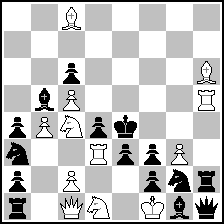 (= 12+15 ) (= 12+15 )
s#3
1.Bg7! [2.Sc3+ d:c3 3.R:e3+ S:e3#]
1...R:h5 2.Sd6+ Kd5 3.Sd:e3+ S:e3#
1...R:c1 2.Bf5+ Kd5 3.Sc:e3+ S:e3#
1...S:c2 2.R:d4+ S:d4 3.Q:e3+ S:e3#
1...Sb1 2.S:f2+ e:f2 3.Sd2+ S:d2#
1...Sg~ 2.Sd2+ e:d2 3.S:f2+ R:f2,B:f2#
(1...B:c4 2.Bf5+ Kd5 3.S:e3+ S:e3#)
Both sort of "sins" are committed here:
a) the same mate 3...S:e3 appears on most of the main variations;
b) the variation after 1...Sg~ ends with two mates possible.
(2)
Uri Avner
1st Prize Israel Ring Tourney 1981
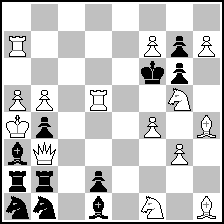 (= 14+11 ) (= 14+11 )
s#3
Set:
1...R:b3 (a) 2.Rd6+ (A) Kf5 3.Se3+ R:e3#
1...Rc2 (b) 2.Qc3+ (B) b:c3 3.f8=Q+ B:f8#
1...S:b3 (c) 2.Se4+ (C) Ke6 3.Sc5+ S:c5#
1...Sc2 (d) 2.Ra6+ (D) Ke7 3.Q:b4+ S,R,B:b4#
Solution:
1.Qc2! waiting
1...Rb3 (a) 2.Qc3+ (B) b:c3 3.f8=Q+ B:f8#
1...R:c2 (b) 2.Se4+ (C) Ke6 3.Sc5+ R:c5#
1...Sb3 (c) 2.Ra6+ (D) Ke7 3.Qc5+ S:c5#
1...S:c2 (d) 2.Rd6+ (A) Kf5 3.Se3+ S:e3#
(1...B~ 2.Qc3+ b:c3 3.f8=Q+)
Here, only one of the "sins" is committed: after the set's 1...Sc2 there appear three possible black mates!
Surely there are more examples worth showing. In fact I'm looking for suitable examples for a planned article on this subject; good examples are welcome, as well as comments and opinions!
|
|
| (2) Posted by David Knezevic [Tuesday, Nov 21, 2006 11:10] |
The article "Dual oder nicht Dual - das ist keine Frage" by Frank Richter has just been published in Die Schwalbe (October 2006) on similar (or same) subject. However, this question is very interesting and deserves more discussions (and articles). Uri, I would be glad to publish your article in Mat Plus if you have not planned something else.
I personally make the difference between dual mates in selfmate and consider those forced by white checking moves unppleasant (if not worse) - like three set mates on b4 in your example 2. On the other hand duals from black zugzwang, i.e. after quiet white moves (like random battery opening) don't bother me. But it's only my view, not a "rule".
|
|
| (3) Posted by Harry Fougiaxis [Tuesday, Nov 21, 2006 11:44]; edited by Harry Fougiaxis [06-11-22] |
I am no selfmate specialist myself, but since you are asking for opinions, here you are. I remember, almost 25 years ago, when I was a teenager, I asked Pavlos Moutecidis if different black mates are considered duals in the selfmates and he immediately replied "Don't bother, of course they are not. The important point are the white moves to be unique, since the aim of the stipulation is exactly this : White to oblige Black to deliver mate".
I don't really know what changed after all these years to make one of the leading experts claim nowadays that multiple black mates should be penalised. I read his article(s) (I think they were published in Orbit, or it was StrateGems?!), but frankly speaking I was not convinced, for I could not find a sufficient justification presented in it. On the contrary, Richter analyses the codex itself and, in my opinion, he properly documents his point of view.
I would suggest PCCC to deal with this issue in the Varna meeting. I don't like at all to see fine compositions downgraded and/or kicked out altogether to the trash bin, due to such an erroneous belief.
|
|
| (4) Posted by Uri Avner [Tuesday, Nov 21, 2006 13:44]; edited by Uri Avner [06-11-24] |
Thanks, Milan, for the information. I'm looking forward to the arrival of Die Schwalbe with Frank's article. Thanks for offering Mat Plus as stage for my intended article, which I would be happy to use. I hope, however, to find time to complete this work in the near future. As I've said, I still need good examples for all kind of arguments (I would like to add that for particular cases I don't deny the possible advantage of unique mates etc). The two selfmates that I've shown are, however, free of any consideration regarding the black mates, and therefore their mates are, in a way, irrelevant. The three possible mates in the set variation of no.2 can be viewed as additional baroque-like content (witout which I doubt if the 4-fold Lacny could be attained at all).
|
|
| (5) Posted by Frank Richter [Tuesday, Nov 21, 2006 15:20] |
I completely agree with Harry. In generally there is nothing what you have to add to Pavlos' statement.
But in the last years especially P.A.Petkow more and more propagates his persuasion, that multiple black mating moves have to be considered as duals and (consequently) the corresponding problems are INCORRECT (f.i. refer to Uralski Problemist, 44/2005). And as a result of this "theory" some problems by Papack, Kovacevic, Gamnitzer and me (and may be by other componists too) were (or should be) excluded from miscellaneous tourneys or were lower placed.
Of course everyone may explain his own aesthetic or whatever principles. But in my opinion it is not acceptable, that chess problems not fullfilling these criteria were arbitrarily disqualified. That's what I (and a lot of other wellknown problemists too) wanted to explain in the Schwalbe-article.
@Uri: It will be difficult to find such examples you are looking for. For it thematic mating moves are needed - but such s# problems I really don't remember.
|
|
| (6) Posted by Uri Avner [Tuesday, Nov 21, 2006 15:39] |
Frank, I completely agree with you. The personal bias of one composer, no matter how great he is, cannot dictate the taste of so many first rank composers who prefer to keep their minds free of any such dogmas. All we can do is to make the other voices be heard.
|
|
| (7) Posted by Miodrag Mladenović [Tuesday, Nov 21, 2006 20:58] |
I agree. For me multiple mating moves by black are not duals. Why they should be. If it's not dual to have different defenses on some of previous moves (1st black etc.) why it should be dual on the last move.
|
|
| (8) Posted by Hartmut Laue [Tuesday, Nov 21, 2006 21:50] |
The issue in question is a matter of correct logical thinking and not subject to "voting". I give a translation of Volker Gülke's and my own postscriptum to Frank Richter's article in "Die Schwalbe" 221 (Oct 2006):
A selfmate in n moves is a chess problem in which Black is compelled by White to checkmate White in at most n moves. At each point of the solution, White must be able to reach this aim in the remaining number of moves after each legal move by Black. For the position after the n-th (i.e. last) move by White this simply means that now each legal move by Black must be a mating move. It is an obvious logical mistake to conclude from this the completely different statement that after the n-th move by White there must exist a unique legal move by Black. Thus a simple logical analysis of the selfmate stipulation has the following consequence:
The expression "mating dual" makes no sense with respect to selfmates.
It therefore goes without saying that multiple mating moves in selfmates are in no way a formal defect. Neither a possible publication nor a possible inclusion in an award is a priori negatively influenced by their existence in a selfmate.
So far the contents of the German text on p. 560 by Volker Gülke and myself. I'd like to add: The point is that multiple mating moves in a selfmate can not formally disqualify the problem from being published or from being honoured by inclusion in the award, or in the FIDE Album. They are not a technical flaw or constructional mistake. Of course, this does not exclude the possibility that a judge considers them an artistic weakness in a given case for specific reasons. It is, however, completely unacceptable to reject a selfmate automatically just because it has multiple mating moves. Likewise it is an unacceptable violation of artistic principles to induce other authors to add otherwise superfluous extra material in their selfmates merely in order to make a mating move unique. There is strong evidence that both anti-artistic aberrations have already taken place.
Hartmut Laue
|
|
| (9) Posted by Hauke Reddmann [Wednesday, Nov 22, 2006 13:00] |
I totally agree on the *logical* side - those aren't duals,
by definitionem, case closed, please use attached fisticuffs
for further discussion of matter. :-)
But nevertheless, it might be *artistically* annoying:
H. Reddmann, feenschach #6003 (issue ?/year 19?? - please
amend source if possible!)
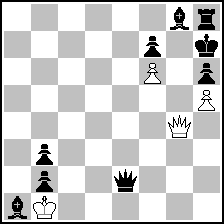 (= 4+9 ) (= 4+9 )
8 stipulations: #/=/s#/s=1 Duplex
The white s= of course goes 1.Qxg8+ K,Txg8=. Stale or not, the same
reasoning applies: this is a variant. But it still sucks, as
a commenter said (not in this wording, but in any case I agree fully :-)
Hauke
|
|
| (10) Posted by Thomas Maeder [Wednesday, Nov 22, 2006 18:14] |
The PCCC's Codex sub-committee did discuss question b) (question a) is totally new to me and makes even less sense), if I remember correctly. Their position is that the current Codex already says that multiple mating moves are *not* duals. Their suggestion is to add a footnote further clarifying the issue.
The report of the Codex sub-committee was heard, but hardly discussed by the PCCC. Decisions were postponed to next year to allow the countries to discuss the matter.
|
|
| (11) Posted by Uri Avner [Saturday, Nov 25, 2006 11:50] |
Our discussion touches upon the important subject of JUDGMENT.
Every composer has, understandably, his own preferences; but when he takes upon himself the task of judging, he must be able to put aside his own prejudices, at least to a large degree, in order to perform his task fairly and reliably.
In his essay "Of the Standard of Taste" (1757), the philosopher David Hume refers to the exact questions we are dealing with today in our field of Chess Composition; so much so that I sometimes wonder: did he compose any chess problems himself?...
The essay can be found (among other places) at:
http://www.mnstate.edu/gracyk/courses/phil%20of%20art/hume%20on%20taste.htm#3
Highly recommended!
|
|
| (12) Posted by Frank Richter [Monday, Nov 27, 2006 20:23] |
Dear Uri,
just today I remembered an own problem, that may be work as a good example for "bad" black multiple mating moves.
Frank Richter
8597 feenschach 146 2002
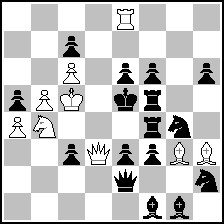 (= 9+16 ) (= 9+16 )
1.Sa6! (2.De4+ K:e4#)
1.- Dc2 2.D:c3+ Ke4,D:c3#
1.- Sf2 2.D:e3+ Se4,D:e3#
These variations shall show a black adaption of the Thema B (Black opens a black line, therefore Black can close another own line in the mating move). At first these adaption seems to be too abstract in general, but especially the double mating moves make it impossible to discover the idea.
Who likes can enjoy the thematic tries 1.Sa2/Sc2? Dc2/Sf2!
|
|
| (13) Posted by Uri Avner [Tuesday, Nov 28, 2006 08:37]; edited by Uri Avner [06-11-28] |
Hello Frank,
I suppose you meant "White opens a black line..."
What makes your theme difficult to detect is not necessarily the double mate, but mainly the already existing black ambush behind the wQ. In order to be easily detected, the ambush behind the wQ should be created during play. Ideally, tries should exist showing that without the creation of this ambush, there would be no mate because of the uncompensated closure of a black line.
One of my early selfmates shows a clear necessity of unique black mates:
Uri AVNER
Israel Problemists Association10th JT 1956-57
3rd Prize
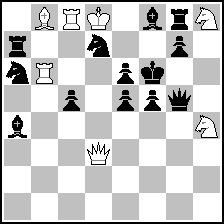 (= 7+13 ) (= 7+13 )
s#2*
1...Sd:b8 2.R:e6+ K:e6#
1...S:b6 2.B:e5+ K:e5#
1.Qd6! (2.Qe7+ B:e7#)
1...Sd:b8 2.Q:e5+ K:e5#
1...S:b6 2.Q:e6+ K:e6#
The problem shows not only White Changes, but also Reciprocal Change of Black Mates. In this case it goes without saying that unique black mates are mandatory.
|
|
| (14) Posted by Hartmut Laue [Tuesday, Nov 28, 2006 19:29] |
@ Frank
"Who likes can enjoy the thematic tries 1.Sa2/Sc2? Dc2/Sf2!"
-- Who would NOT like them?? In my eyes, the problem would lose a lot without them!
|
|
| (15) Posted by Harry Fougiaxis [Wednesday, Jan 31, 2007 13:45]; edited by Harry Fougiaxis [07-02-01] |
I received the latest Uralsky Problemist issue No.47 (3/2006) yesterday, and I noticed that there is an article by Yakov Vladimirov on this subject. Could someone who understands Russian give a brief summary?
|
|
| (16) Posted by Frank Richter [Wednesday, Jan 31, 2007 19:34] |
One of the main conclusions: multiple mates are a naturally part of selfmates (and not duals ...).
|
|
| (17) Posted by Marek Kwiatkowski [Thursday, Feb 15, 2007 18:59] |
The following example can be crucial to this delayed discussion.
Eugeniusz Iwanow
3rd PR Diagrammes 1991
 (= 8+8 ) (= 8+8 )
S#2
set: 1…Qb7 2.Sd5+ Q(R)d5#, 1…Qc8 2.Bc3+ Q(B)c3#;
try: 1.Rc6? (~2.Sd5+ Q(R)d5#) Qc6 2.Bc3+ Q(B)c3#, but 1…d2!;
key: 1.Bc6! (~2.Bc3+ Bc3#) Qc6 2.Sd5+ Q(R)d5#, 1…d2 2.Qa4+ Sa4#
All that was possible by discovery an organic relation (between wQ and bB, bR), which leads to a ready combination of the Ruchlis and Le Grand themes
This unusual problem appeared in the FA 89-91 (F1) as reciprocal change with 8 (2,5-3-2,5) points. By the way, the second judge was … Petko Petkov.
|
|
| (18) Posted by Paz Einat [Thursday, Feb 15, 2007 22:34] |
A nice problem indeed showing...the Le Grand theme.
|
|
| (19) Posted by Frank Richter [Friday, Apr 6, 2007 15:02] |
My mistake in the post 12 above:
The correct source of the s#2 is 8597 feenschach 146 2002.
|
|
| (20) Posted by Administrator [Friday, Apr 6, 2007 16:11] |
QUOTE
FrankRichter: The correct source of the s#2 is 8597 feenschach 146 2002.
Correction done by Administrator in original post!
|
|
Read more... |
Page: [Previous] [Next] 1 2
MatPlus.Net  Forum Forum  General General  Mates in Selfmates: Two Fallacies Mates in Selfmates: Two Fallacies |
 ISC 2024
ISC 2024 Forum
Forum  General
General  Mates in Selfmates: Two Fallacies
Mates in Selfmates: Two Fallacies 


